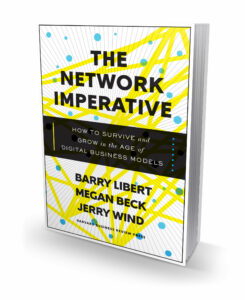How to Survive & Grow in the Digital Age
How do you create value today?
What’s the best way to scale an enterprise?
How do you grow a company faster than ever and scale with lower cost?
It’s all possible if you leverage the network.
That’s how companies like Amazon, Airbnb, and Uber have succeeded against the odds.
In The Network Imperative: How to Survive and Grow in the Age of Digital Business Models , authors Barry Libert, Megan Beck and Jerry Wind argue that it is the way companies create value. And today, the best way to create value is through scalable and digitally networked business models – like Amazon, Google, Uber, Airbnb – that leverage networks of employees, customers, and suppliers.
Create a Virtual Network
For those not yet familiar with your work, what’s the network imperative?
The network imperative is recognizing that today’s most valuable companies are virtual networks that rely on digital platforms. This leading edge, new business model is emerging in every industry: Amazon and Alibaba in the retail industry, Match.com and Tinder in dating, Facebook and Instagram in Social Media, LinkedIn in professional resumes, Airbnb and Homeaway in room rentals, Uber and Lyft in shared car services, as well as the NYSE and NASDAQ in the financial sector.
What did your research show in terms of the financial results of “network orchestrators” versus the other 3 business models?
These business models – which we call Network Orchestrators – are more about orchestrating resources, be it insights, relationships, cars, homes, and skills rather than owning them. In addition, they scale based on the a flywheel effect , e.g. the more people, services and interactions there are on the network, the more others will join and make available their assets – whether that’s friends, photos, resumes, cars or homes.
5 Steps to Become Network Centric
Would you briefly describe the PIVOT model?
Our research indicates that all organizations have dormant, virtual networks of either employees, customers, prospects, suppliers, investors or alumni that, when combined with a digital platform and a clear incentive system to share what they have, what they know and who they know with others, can apply network orchestration to their business model. To help incumbents transition from firm centered (where they focus on what they make, market and sell) to network centric (where they orchestrate what others have and create peer-to-peer connections), we created a 5 step process called PIVOT. The 5 steps are:
- Pinpoint your current business model (e.g. which of the 4 business models are you? Asset builder, service provider, technology creator or network orchestrator?)
- Inventory all your assets both tangible (e.g. plant, property and equipment as well as money) and intangible (brand, intellectual capital and relationships as well as interactions and big data).
- Visualize your future digital platform that connects your network of people or things.
- Operate your new digital network and virtual platform alongside your existing business and protect it while it grows, experimenting along the way to find the sweet spot that insures its success.
- Track using new big data metrics such as engagement, sentiment or interaction along with traditional financial measures to see how your network is doing and the value it creates.
As you work with corporate leaders, what is the reaction to PIVOT? Who is more likely to resist this shift?
Most leaders find PIVOT a process and framework that they can understand and adopt, not unlike Reengineering was 20 plus years ago. The organizations and leaders that are more likely to resist are those that still can’t get past their existing attitudes, behaviors and beliefs about what an organization is – e.g. internally focused on its people, its products and its processes. Network orchestration requires a completely different mental model.
What new thinking is required in this new era?
Today’s network mental model requires an overhaul in leadership thinking. It starts from outside in rather than from inside out. It is founded on the belief that there are excess assets and resources in the world that are underused and undervalued and that by connecting them and allowing the owners of these assets (that includes you and me and our friends, our cars, our homes, our knowledge) to share what they have with others, everyone benefits. Further, by enabling peer-to-peer co-creation, new and unprecedented value is created such as in the case of Uber and Airbnb as assets and resources are released into the world.
Invert Your Core Beliefs
What does it mean to invert your core beliefs?
 Most leaders today were brought up in the industrial world of thinking where they were taught that economies of scale matter. Economies of scale are based on the more resources you control, the more you can make and the more you can make, the lower the cost is of making it. Further, it is based on Porter’s 5 forces of competition. All of these assumptions surely worked for the last 200 years, e.g. for the industrial era of material reality. But in the age of intangibles such as insights, data, brand and interactions, scaling is less costly and more efficient, and controlling intangibles such as you and me is less possible let alone acceptable to the millennials. As such, inverting your core beliefs is about understanding that in the age of intangibles, sharing is a critical component of success, as are a digital platform and virtual network that connects you to me and what you have to what I want with the organization acting as the orchestrator and facilitator.
Most leaders today were brought up in the industrial world of thinking where they were taught that economies of scale matter. Economies of scale are based on the more resources you control, the more you can make and the more you can make, the lower the cost is of making it. Further, it is based on Porter’s 5 forces of competition. All of these assumptions surely worked for the last 200 years, e.g. for the industrial era of material reality. But in the age of intangibles such as insights, data, brand and interactions, scaling is less costly and more efficient, and controlling intangibles such as you and me is less possible let alone acceptable to the millennials. As such, inverting your core beliefs is about understanding that in the age of intangibles, sharing is a critical component of success, as are a digital platform and virtual network that connects you to me and what you have to what I want with the organization acting as the orchestrator and facilitator.
Become a Network Imperative Leader
How do leaders guard against falling back to their former mental models?
By asking two questions:
- Are you sure that your current beliefs are serving you well in today’s economy?
- Are you absolutely sure?
If either of the answers to these two questions is no, then it is time to apply the next 3 steps to your mental model beliefs:
- Invert your core assumptions (from ownership to access, from controlled to shared, from pipe to network, from physical to digital, from transaction to subscription, from closed to open source, etc.).
- Test your new core beliefs in the market with customers, employees, freelancers, investors and suppliers.
- Roll out your new core beliefs as your future business model.
What are the characteristics of a “network imperative” leader?
The single most important characteristic is that they are open minded!
The Network Imperative: How to Survive and Grow in the Age of Digital Business Models


